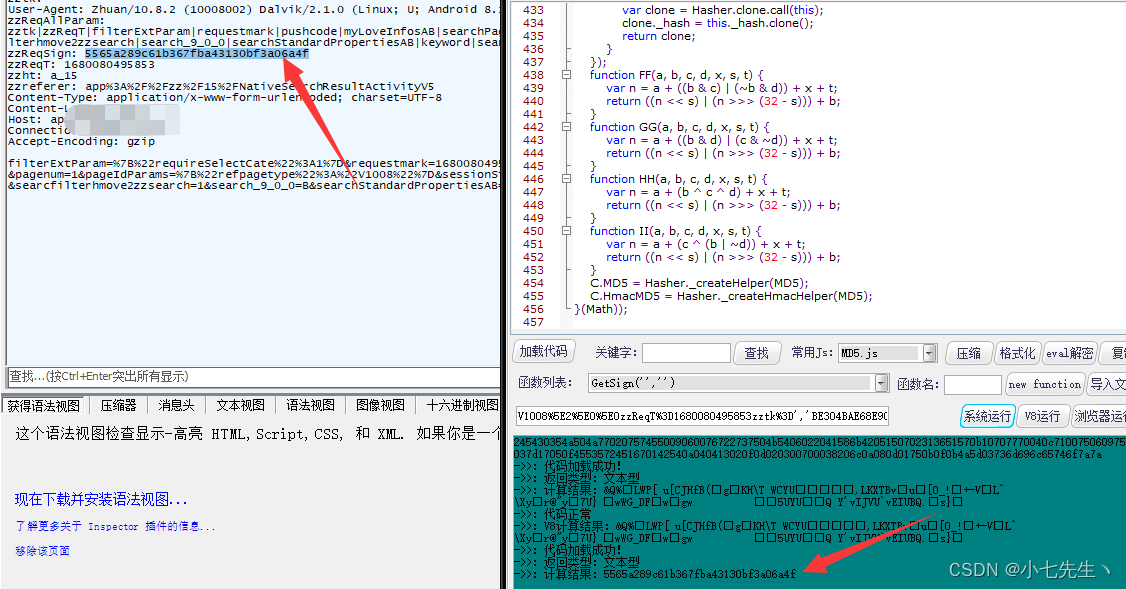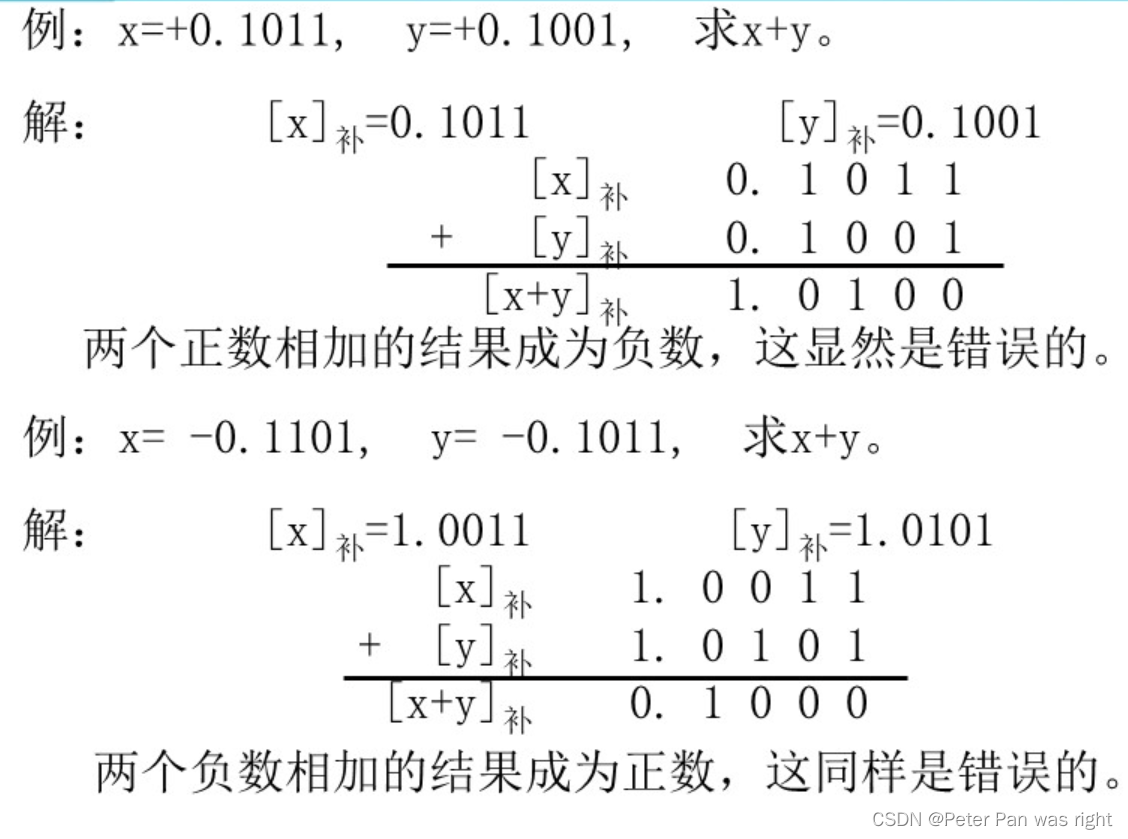赛况
C题可惜,比赛时模拟没有想明白,只对了一半,赛后看了大佬们的题解后恍然大悟,而F题是压根没思路,况且F题部分分也比较难拿。

题目列表

A-小红的数位删除

思路
将读入的数字整除10做三次后输出即可
参考代码
#include <bits/stdc++.h>
using namespace std;
using ll = long long;
const int N = 1e5+5,INF = 0x3f3f3f3f;
int n;
int main(){
ios::sync_with_stdio(0),cin.tie(0),cout.tie(0);
cin >> n;
int cnt = 0;
while(cnt!=3){
cnt++;
n/=10;
}
cout << n << '\n';
return 0;
}B-小红的小红矩阵构造

思路
如果元素和不等于x,则输出wrong answer,否则判断其每行和每列的异或和是否与第一行和第一列相等,若不相等,则输出wrong answer,最后所有条件都满足,则输出accepted
参考题解
#include <bits/stdc++.h>
using namespace std;
using ll = long long;
const int N = 1e2+5,INF = 0x3f3f3f3f;
int a[N][N];
int n,m,x;
int main(){
ios::sync_with_stdio(0),cin.tie(0),cout.tie(0);
cin >> n >> m >> x;
for(int i = 1;i<=n;i++){
for(int j = 1;j<=m;j++){
cin >> a[i][j];
}
}
int sum=0;
for(int i = 1;i<=n;i++){
for(int j = 1;j<=m;j++){
sum+=a[i][j];
}
}
if(sum!=x){
cout << "wrong answer\n";
return 0;
}
int rowxor=0,columnxor=0;
for(int i = 1;i<=m;i++) rowxor^=a[i][1];
for(int i = 1;i<=n;i++) columnxor^=a[1][i];
for(int i = 2;i<=n;i++){
int nowxor=0;
for(int j = 1;j<=m;j++){
nowxor^=a[i][j];
}
if(nowxor!=rowxor){
cout << "wrong answer\n";
return 0;
}
}
for(int i = 2;i<=m;i++){
int nowxor=0;
for(int j = 1;j<=n;j++){
nowxor^=a[j][i];
}
if(nowxor!=columnxor){
cout << "wrong answer\n";
return 0;
}
}
cout << "accepted\n";
return 0;
}C-小红的白色字符串

思路
如果遇到大写字母,它前面若不是' '(空格),那么答案ans++,并且把当前大写字母用' '覆盖,最终输出ans即可
参考题解
#include <bits/stdc++.h>
using namespace std;
string s;
int main() {
ios::sync_with_stdio(0),cin.tie(0),cout.tie(0);
cin >> s;
int ans = 0;
for(int i = 1;i<s.size();i++){
if(s[i]>='A'&&s[i]<='Z'&&s[i-1]!=' '){
ans++,s[i]=' ';
}
}
cout << ans << '\n';
return 0;
}D-小红走矩阵

思路
BFS模板题,直接全程默写
参考题解
#include <bits/stdc++.h>
using namespace std;
using ll = long long;
const int N = 1e3+5,INF = 0x3f3f3f3f;
struct Node{
int x,y,s;
}t,t1;
char graph[N][N];
bool vis[N][N];
queue<Node> q;
int dx[4]={0,0,-1,1};
int dy[4]={-1,1,0,0};
int sx,sy,ex,ey;
int n,m;
void bfs(){
sx=1,sy=1,ex=n,ey=m;
t.x=sx,t.y=sy,t.s=0;
q.push(t);
vis[sx][sy]=1;
while(!q.empty()){
t = q.front();
// cout << t.x << ' ' << t.y << '\n';
q.pop();
if(t.x==ex&&t.y==ey){
cout << t.s << '\n';
return;
}
for(int i = 0;i<4;i++){
int u=t.x+dx[i],v=t.y+dy[i];
if(u<1||u>n||v<1||v>m||vis[u][v]||graph[u][v]==graph[t.x][t.y]) continue;
vis[u][v]=1;
t1.x=u,t1.y=v,t1.s=t.s+1;
q.push(t1);
}
}
cout << "-1\n";
}
int main(){
ios::sync_with_stdio(0),cin.tie(0),cout.tie(0);
cin >> n >> m;
for(int i = 1;i<=n;i++) for(int j = 1;j<=m;j++) cin >> graph[i][j];
bfs();
return 0;
}E-小红的小红走矩阵
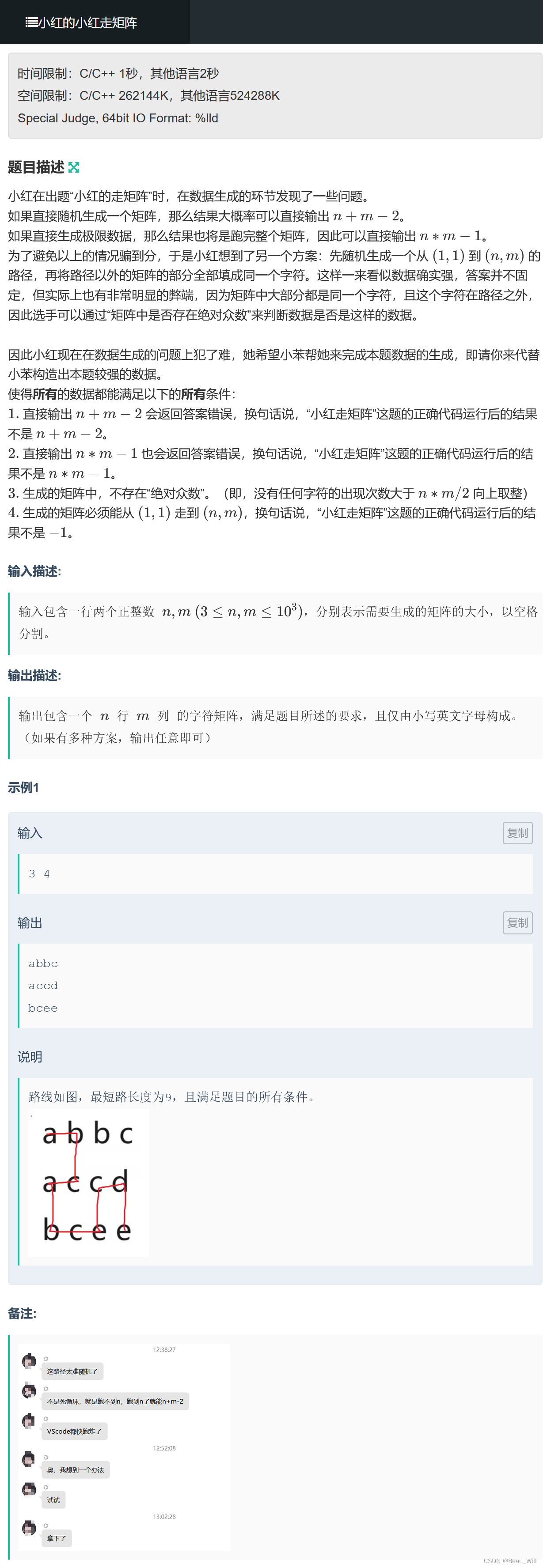
思路
我们自己随便定一条步数介于n+m-2至n*m-2直接的一条通路即可,当然注意生成的字母最好稀疏一点,我找的路如下图。
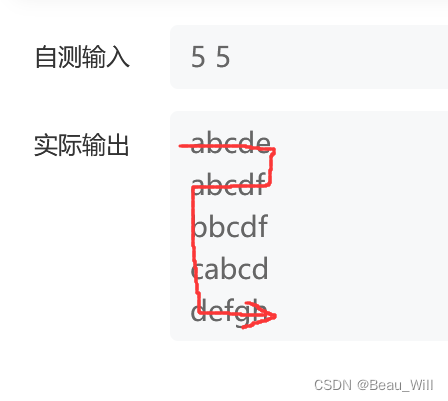
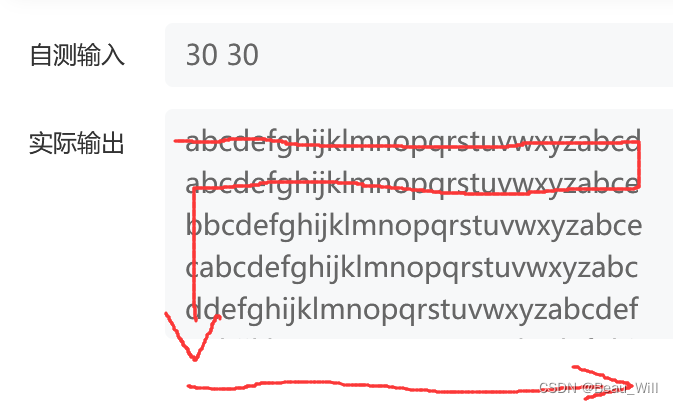
路的生成就是模拟遍历,确保第1、2、3行的第2至m-1列的字母都相同,其余拐点位置为上个位置的下一个字母,注意转换的时候对26取模,避免超出'a'到'z'的范围。剩余其他所有位置,循环从'a'到'z'生成即可。
参考题解
#include <bits/stdc++.h>
using namespace std;
using ll = long long;
const int N = 1e3+5,INF = 0x3f3f3f3f,mod = 26;
char graph[N][N];
int n,m;
int main(){
ios::sync_with_stdio(0),cin.tie(0),cout.tie(0);
cin >> n >> m;
for(int i = 1;i<=m;i++) graph[1][i]='a'+(i-1)%mod;
graph[2][m]='a'+(graph[1][m]-'a'+1)%mod;
for(int i = m-1;i>=1;i--) graph[2][i]=graph[1][i];
for(int i = m;i>=2;i--) graph[3][i]=graph[2][i];
graph[3][1]='b';
for(int i = 4;i<=n;i++) graph[i][1]='a'+(i-2)%mod;
for(int i = 2;i<=m;i++) graph[n][i]='a'+(graph[n][1]-'a'+i-1)%mod;
int cnt=0;
for(int i = 1;i<=n;i++){
for(int j = 1;j<=m;j++){
if(graph[i][j]>='a'&&graph[i][j]<='z') continue;
if(cnt==26){
cnt=0;
}
graph[i][j]='a'+cnt;
cnt++;
}
}
for(int i = 1;i<=n;i++){
for(int j = 1;j<=m;j++){
cout << graph[i][j];
}
cout << '\n';
}
return 0;
}F-小红的好子串询问
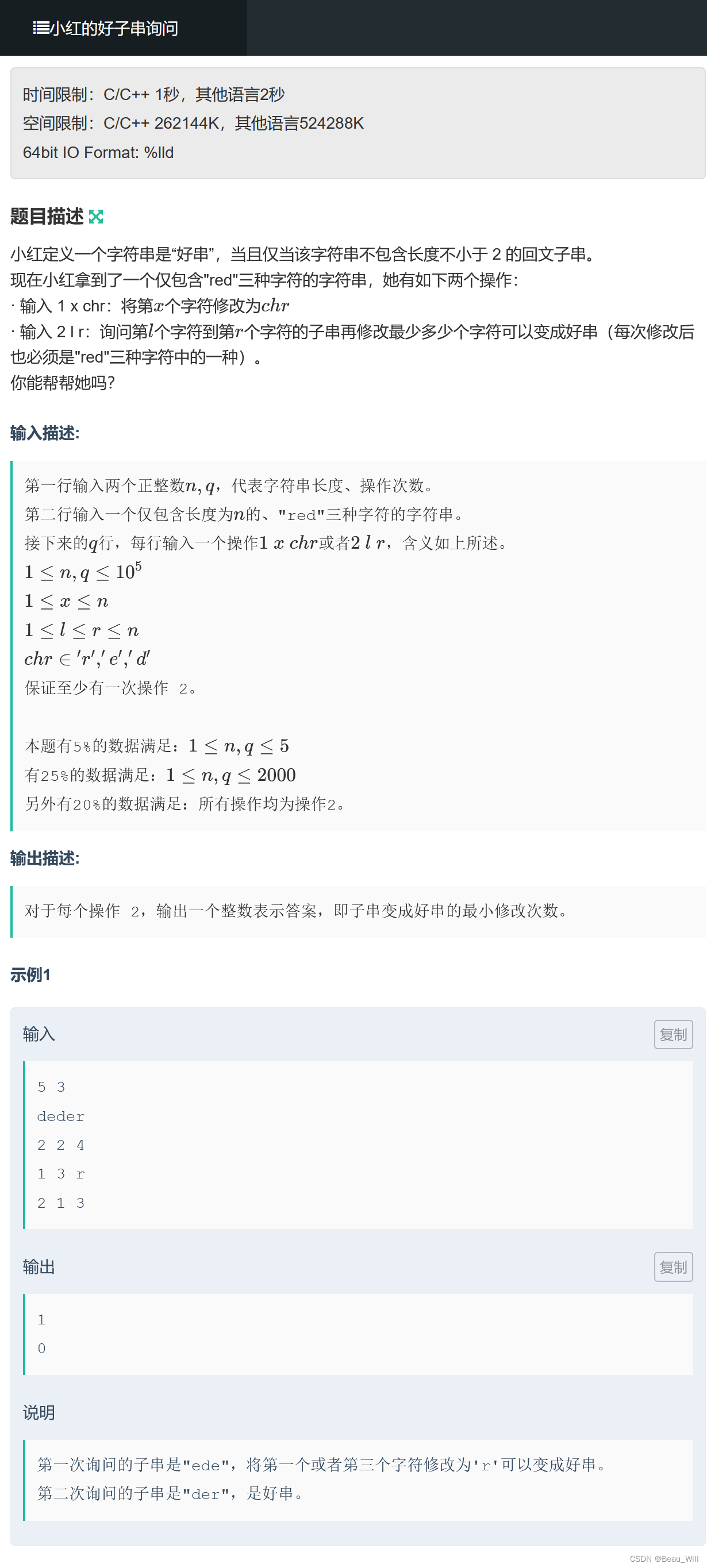
思路
预处理出不是回文串的只含三个字母且不重复的字符串。修改和查询都使用树状数组实现
参考题解
(感谢橙名大佬牛客288141082号提供的题解)
#include<bits/stdc++.h>
using namespace std;
typedef long long ll;
#define N 100000
int i,j,k,n,m,t;
string s,s1,_s[7]={"","red","rde","dre","der","erd","edr"};
int f[7][N+50];
void add(int f[],int x,int y){for(;x<=n;x+=(-x&x)){f[x]+=y;}}
int get(int f[],int x,int y=0){for(;x;x-=(-x&x)){y+=f[x];}return y;}
int main(){
ios::sync_with_stdio(0); cin.tie(0);
cin>>n>>t>>s; s="$"+s;
for(i=1;i<=n;i++){
for(j=1;j<=6;j++){
add(f[j],i,s[i]!=_s[j][i%3]);
}
}
while(t--){
int l,r,res,op;
cin>>op;
if(op==1){
cin>>l>>s1;
for(j=1;j<=6;j++){
add(f[j],l,-(s[l]!=_s[j][l%3]));
}
s[l]=s1[0];
for(j=1;j<=6;j++){
add(f[j],l,(s[l]!=_s[j][l%3]));
}
}
else{
cin>>l>>r;
res=1e9;
for(i=1;i<=6;i++){
res=min(res,get(f[i],r)-get(f[i],l-1));
}
cout<<res<<'\n';
}
}
}





